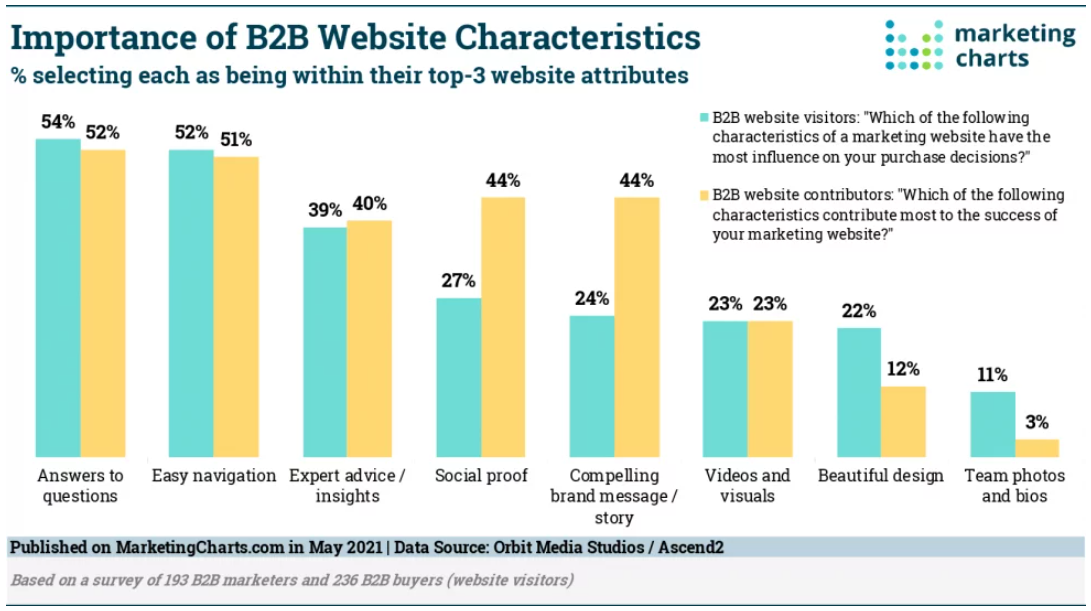Prioritize Your Content

BUT FIRST, CONTENT
We’ve created hundreds of websites for clients over the years. And oftentimes, creating content is the most difficult part of the process. It’s easy to focus on the color palette, visuals and template designs, and forget about the fact that the pages on a website are there for a reason: to inform visitors of important information they are seeking. A recent study done by Orbit Media Studios and Ascend2 found that 54% of B2B website visitors listed ‘answers to questions’ as the most important website characteristic.

So, we’ve adopted a strategy that places an emphasis on content before design.
USER-CENTERED DESIGN APPROACH
Our content-first design approach is about knowing the purpose of each page before actually designing any templates. By understanding the various content types the site will have, we can plan for unique and customized blocks. So instead of having one standard interior page template for everything, we can create custom templates that showcase each page’s content in a visually appealing way.
STEP ONE: CONTENT AUDIT
We start by doing an audit of the client’s existing website to answer questions like:
- What pages are currently on the site
- What content is on those pages
- What updates can be made to the content
- Do any pages need to be added or removed
- Are there any design elements (like photo galleries or videos) that we need to incorporate into the content plan for a page
If the client doesn’t have an existing website and we are writing all new content, then we ask questions like:
- What important information will your customers look for on the website
- In what order should the information be displayed
- What keywords or key phrases should be included
While working on the content audit, we are also creating user personas and user journeys to help us understand the target audiences and how they will be interacting with the website.
QUICK RECAP: USER JOURNEYS AND PERSONAS
A user persona is a semi-fictional representation of your current and target customers.
A user journey is a visual representation of the process a customer or prospect goes through to achieve a goal with your company.
The user personas and user journeys provide answers to two of the most important questions:
- Who is going to be using the site?
- How are they going to use it?
That information is incredibly important to have when working on the content. The answers to those questions help to prioritize the content into must have, nice to have and unnecessary based on the target audiences and the goals they are trying to accomplish on the site.
STEP TWO: OPTIMIZING THE NAVIGATION
Once we have the content audit, user personas and user journeys complete, we can start planning for the framework of the website. A well-thought out main navigation structure is important for a positive user experience. It can be tempting to add every page to the main navigation but that is more harmful than helpful to website visitors. If there are pages that are important but not vital to the website visitor completing their goals, those can be added to the footer navigation. We recommend not having more than six pages in the main navigation.
Our Lead Designer and Content Manager work together to determine what pages should be in the main navigation, if any secondary navigation is needed and the order of those navigation items. We send that navigation outline to the client for approval before moving forward with the content creation.
STEP THREE: CONTENT CREATION
Once we have approval on the navigation outline, we can move forward with the content outline. We work with the client to gather all of the content that should be included on each page, including text, images, videos and quotes. It’s important to know all of the elements that will be included on a page before starting the design template so our Designer can work them into the template design, rather than trying to make it work after the design is done. Our Content Manager works the content into an outline per page, including headers, subheadings, body paragraphs, and any quotes or callouts that can be used in the design. We also make sure to optimize the content on each page for on-site SEO with keyword and keyphrase research.
QUICK RECAP: KEYWORD RESEARCH
When writing content for a page it is important to think of what and how potential customers are searching for – terms, phrases, examples, etc.. Keyword research is a great way to determine what people are searching for and how many people are searching for it. To do keyword research for your website, start by searching one of your possible keywords in Google, and then scroll to the bottom and look at the related searches. Those related search terms give a great insight into other terms/phrases people are searching for that are relevant to your selected keyword. Create a list of all possible keywords based on these preliminary searches and then use the Google Keyword Planner tool to determine the popularity of each term on the list. Best practices are to choose three keywords per page to use throughout page titles, meta descriptions, headings, and page copy.
STEP FOUR: CONTENT APPROVAL
Before moving onto the design, we send the content outline to the client for approval. This helps to keep the client engaged in the process and thinking about what they want included in the final product. The content management system will allow for content additions when the website is complete, but an initial approval on the content outline helps for planning the design and development.
STEP FIVE: CONTENT AND DESIGN PITCH
When the initial design mockup is complete, the Designer and Content Manager will meet with the client to walk through the design and how it complements the content. This meeting gives the client the opportunity to review, ask questions and get a feel for how the final product will look before starting the development process. This is the time to make revisions if any are necessary. Once the design mockup is approved it’s time for development.
STEP SIX: PRE-LAUNCH CONTENT ENTRY AND REVIEW
As development progresses, we can start creating pages and adding content to the pages. The approved content outline is an important reference for this step in the process as it has the headers, body copy and any visual elements listed that should be included on each page. Our team combs through the site to make sure everything is included and working properly.
CONTENT CREATION FOR A SUCCESSFUL SITE
As you can see from the six steps listed above, content plays a large part in the creation of a website. And when that content is outlined and created before the design and development, it works with the elements rather than trying to fit predetermined parameters.

